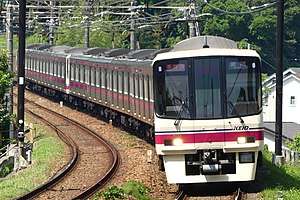Keio 8000 series
The Keio 8000 series (京王8000系) is an electric multiple unit (EMU) train type operated by the private railway operator Keio Corporation on commuter services in the Tokyo area of Japan since 1992.
| Keio 8000 series | |
|---|---|
 8000 series 10-car set 8706 in May 2017 | |
| In service | 1992 – Present |
| Manufacturer | Nippon Sharyo, Tokyu Car Corporation |
| Constructed | 1992 - 1999, 2009 |
| Number built | 245 vehicles |
| Number in service | 244 vehicles |
| Number scrapped | 1 vehicle (accident damage) |
| Formation | 4/6/8/10 cars per trainset |
| Operator(s) | Keio Corporation |
| Specifications | |
| Car body construction | Stainless steel |
| Car length | 20 m (65 ft 7 in) |
| Doors | 4 pairs per side |
| Maximum speed | 110 km/h (68 mph) |
| Transmission | GTO-VVVF (Hitachi) SiC-VVVF (Hitachi) |
| Acceleration | 2.5 km/h/s |
| Deceleration | 4.0 km/h/s (4.5 km/h/s for emergency brake) |
| Electric system(s) | 1,500 V DC |
| Current collection method | Overhead |
| Track gauge | 1,372 mm (4 ft 6 in) Scotch Gauge |
Technical details

- MT ratio
- 0 subseries:
- six-car set: 4M2T (4 motor cars and 2 trailers, motor cars have 4 motors)
- four-car set: 2M2T
- 20 subseries: eight-car set: 4M4T
- 0 subseries:
- Motor output: 150 kilowatts (200 hp)
- Gear ratio: 6.07
- Drive mechanism: Parallel cardan
- Control system: GTO-VVVF
- Headlights: Sealed beam
- Destination indicators: roller-blind or 3-color LED
- Passenger information displays: 3-color LED (4 per car)
- Seating arrangement (intermediate cars): 4-7-7-7-4 on longitudinal bench seats
Body
The body is stainless steel. The front is steel.
Driver's cab
"T" shape one handle master-controller system. Digital speedometer. TNS (Train Navigation System).
- Acceleration: 4 notch
- Deceleration: 7 notch + emergency
Formations
As of 1 April 2015, the fleet consists of 14 ten-car sets and 13 eight-car sets (244 vehicles in total), formed as follows.[1]
- c=Driver's cab; T=trailer, M=motor
0-subseries ten-car sets
← Shinjuku Keio-Hachiōji → | ||||||||||
|---|---|---|---|---|---|---|---|---|---|---|
| Tc | M | M | M | M | T | T | M | M | Tc | |
| 8701 | 8001 | 8051 | 8101 | 8151 | 8751 | + | 8801 | 8201 | 8251 | 8851 |
| | | | | | | | | | | | | | | | | | | | | |
| 8713 | 8013 | 8063 | 8113 | 8163 | 8763 | + | 8813 | 8213 | 8263 | 8863 |
| 8714 | 8014 | 8064 | 8114 | 8164 | 8514 | 8564 | 8214 | 8264 | 8864 | |
20-subseries eight-car sets
← Shinjuku Keio-Hachiōji → | ||||||||||
|---|---|---|---|---|---|---|---|---|---|---|
| Tc | M | M | T | T | M | M | Tc | |||
| 8721 | 8021 | 8071 | 8521 | 8571 | 8121 | 8171 | 8771 | |||
| | | | | | | | | | | | | | | | | |||
| 8733 | 8033 | 8083 | 8533 | 8583 | 8133 | 8183 | 8783 | |||
Interior
 Interior of car in original condition
Interior of car in original condition Priority seats of car in original condition
Priority seats of car in original condition- Interior of a refurbished car
 Priority seats of a refurbished car
Priority seats of a refurbished car
History
The first 8000 series trains were introduced in 1992.[2]
Six-car and four-cars sets (and occasionally a pair of four-car sets) used to be operated on splitting services which separated and re-joined at Takahatafudō Station until 2006. Now, all six-car and four-car 0-subseries sets are permanently formed as 10-car trains.[2]
The 8000 series trains are used exclusively on Keio Corporation lines. Unlike some other Keio trains, they do not continue past Shinjuku on to the Toei Shinjuku Line.
Special liveries
Set 8713 received a special all-over green livery in September 2009 evoking the livery carried by the former 2000 series trains.[3]
 Set 8713 in special all-over green livery in August 2016
Set 8713 in special all-over green livery in August 2016
References
| Wikimedia Commons has media related to Keio 8000 series. |
- 私鉄車両編成表 私鉄車両編成表 2015 [Private Railway Rolling Stock Formations - 2015] (in Japanese). Japan: Kotsu Shimbunsha. 23 July 2015. ISBN 978-4-330-58415-7.
- 私鉄車両年鑑 2013: 大手15社営業用車両完全網羅 私鉄車両年鑑2013 [Japan Private Railways Annual 2013] (in Japanese). Tokyo, Japan: Ikaros Publications Ltd. 20 March 2013. p. 153. ISBN 978-4-86320-693-9.
- 高尾山をイメージしたラッピング車両を運行 [Train to run with wrapping livery with Mt Takao theme] (PDF). News release (in Japanese). Japan: Keio Corporation. 24 September 2015. Archived (PDF) from the original on 6 October 2017. Retrieved 6 October 2017.